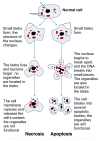Apoptosis and necrosis: two types of cell death in alcoholic liver disease
- PMID: 15706744
- PMCID: PMC6827678
Apoptosis and necrosis: two types of cell death in alcoholic liver disease
Abstract
Heavy alcohol consumption over long periods of time can result in severe liver damage, including death of liver cells (i.e., hepatocytes). Two mechanisms--apoptosis and necrosis--can contribute to hepatocyte death. In apoptosis, the affected cell actively participates in the cell death process, whereas in necrosis the cell death occurs in response to adverse conditions in the cell's environment. Numerous factors that may contribute to the initiation of hepatocyte apoptosis are affected by alcohol consumption. These factors include the enzyme cytochrome P450 2E1 (i.e., CYP2E1), small molecules (i.e., cytokines) involved in cell communication, oxidative stress, and changes in iron metabolism. Similarly, alcohol consumption can influence several factors believed to be involved in hepatocyte necrosis, including depletion of the energy-storing molecule adenosine-triphosphate, reduced oxygen levels (i.e., hypoxia) in the liver, oxidative stress, and bacterial molecules called endotoxins.
Figures
References
-
- Chedid A, Mendenhall CL, Moritz TE, French SW, Chen TS, Morgan TR, Roselle GA, Nemchausky BA, Tamburro CH, Schiff ER, McClain CJ, Marsano LS, Allen JI, Samanta A, Weesner RE, Henderson WG Veterans Affairs Cooperative Study Group 275. Cell-mediated hepatic injury in alcoholic liver disease. Gastroenterology. 1993;105:254–262. - PubMed
-
- Chen Q, Galleano M, Cederbaum AI. Cytotoxicity and apoptosis produced by arachidonic acid in Hep G2 cells over expressing cytochrome P4502E1. Journal of Biological Chemistry. 1997;272:14532–14541. - PubMed
-
- Deaciuc IV, D’Souza NB, Spitzer JJ. Tumor necrosis factor-α cell-surface receptors of liver parenchymal and non-parenchymal cells during acute and chronic alcohol administration to rats. Alcoholism: Clinical and Experimental Research. 1995;19:332–338. - PubMed
Publication types
MeSH terms
LinkOut - more resources
Full Text Sources

